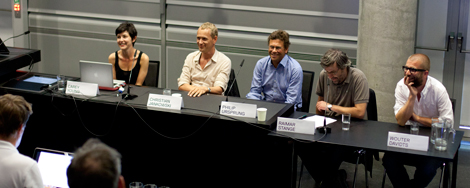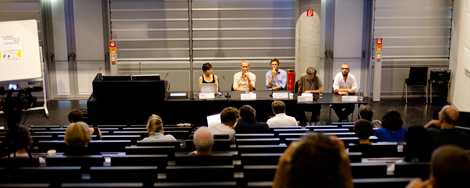| « Art with an emphasis in visual culture | Printing from life » |
Beyond the (traditional) studio
The final lecture evening turned to the general question of going beyond the (traditional) studio. The session was introduced and chaired by Raimar Stange, a freelance curator, art critic and journalist from Berlin.
The first speaker was Carey Young, an artist from London. She has never had a studio. Soon after leaving art school she found herself working for a range of institutions, from a management consultancy to left wing think tank, New Economics Foundation. The spaces and notions of creativity within these organisations inspired her to consider the boundaries and overlaps between culture, politics and business. Her work revolves around creative mental spaces, and the degree to which they have been colonised by corporate interests. She is also interested in ideas of law and legal process, and produces works which respond to the corporate and legal lockdown within our lives.
Philip Ursprung is an American born historian, currently professor of History of Art and Architecture at the Institute for the History and Theory of Architecture at the ETH Zurich. He spoke about Allan Kaprow, and notions of performance and participation. Kaprow’s own studio was quite conventional; but what is important is the socio-cultural context of his work. Ursprung described Kaprow’s “Echo-logy” performance project from 1975. The difference between object and idea in his work became irrelevant, leading to ideas of “immaterial labour”, and the conclusion that the studio is everywhere and cannot be a space protected from economic exploitation.
He was followed by Christian Jankowski, a German artist who is based in Berlin. Jankowski began by confessing that the only time he produced work in a studio, it belonged to someone else. He then recounted several studio experiences. One “studio” in Hamburg was a former shop front, which quickly became performance space. However, through his collaborators he continually found new working spaces. His first office-like working space was in Berlin, but once again he did not produce any work there. Within the space of the studio, he suggests, the artist can carry a godlike status, and the space can serve as a way for the artist to represent himself. But this is not something which has formed Jankowski’s own approach. Rather he seeks to reconsider how we view, interact and construct notions of the “studio”. He illustrated this with his film entitled “Cleaning up the Studio”, a performance piece set within and around the reconstructed studio of Nam June Paik.
Wouter Davidts, Professor of Modern and Contemporary Art at the Vrije Universiteit Amsterdam, rounded of the talks with a discussion about exhibition and the appropriation of creative space by galleries. He focused on the artist Sol LeWitt, who had insisted that “Banal ideas cannot be rescued by beautiful execution”. However, what happens when ideas turned into curatoral happenings? His example was an event at the Van Abbemuseum in Eindhoven, which hosted a project in which Danish art collective SUPERFLEX produced copies of LeWitt’s work and distributed them via a lottery. The entire project, Davidts suggests, raises difficult questions about participation and the relationship between artist and viewer, turning it into a spectacle of productivity which alienates the viewers. The notion that execution is a perfunctionary affair - integral to the conceptual art of LeWitt - and that the performance is merely an invitation, is compromised by this event.
The discussion considered a range of issue raised by the speakers, including: the ways in which the mythos of the studio is upheld and reproduced, as seen in the reconstruction of earlier artist’s studios in which original works are copied; the idea that the notion of the studio haunts both artist and curator; the studio as discursive space; and the ways in which contemporary notions of the traditional studio are themselves constructs which do not accurately reflect historical artistic practices.



